- Courses
- GS Full Course 1 Year
- GS Full Course 2 Year
- GS Full Course 3 Year
- GS Full Course Till Selection
- Online Program
- GS Recorded Course
- NCERT (Recorded 500+ Hours)
- Polity Recorded Course
- Geography Recorded Course
- Economy Recorded Course
- AMAC Recorded Course
- Modern India, Post Independence & World History
- Environment Recoded Course
- Governance Recoded Course
- Science & Tech. Recoded Course
- International Relations and Internal Security Recorded Course
- Disaster Management Module Course
- Ethics Recoded Course
- Essay Recoded Course
- Current Affairs Recoded Course
- CSAT
- 5 LAYERED ARJUNA Mentorship
- Public Administration Optional
- ABOUT US
- OUR TOPPERS
- TEST SERIES
- FREE STUDY MATERIAL
- VIDEOS
- CONTACT US
Chip-In-Ball Technology
Chip-In-Ball Technology
Context
The official Ball manufacturer, Adidas has recently incorporated a microchip into the official ball for Euro 2024 [Football League], providing referees with technological assistance in adjudicating handball decisions throughout the tournament.
Features of this Technology
1. The rechargeable microchip embedded in the 'Fussballliebe,' the official match ball of the Euro 2024, is designed to transmit precise ball data to video match officials in real-time. This technology, utilized in accordance with limb-tracking technology, aids in determining handball incidents leading up to a goal.
2. Working in conjunction with limb-tracking technology, the microchip in the 'Fussballliebe' creates real-time 3D visual representations of players' skeletons.
3. The application of this technology extends beyond handball decisions. It facilitates quicker offside determinations and contributes to the decision-making process of the Union of European Football Associations (UEFA)’s Video Assistant Refereeing (VAR) system. The VAR utilizes data from the microchip to generate an image pinpointing the precise point of contact between the ball and the player's body.
4. Moreover, the microchip enables the technology to ascertain the exact time the ball was kicked, ensuring accuracy in offside decisions. This comprehensive use of technology aims to enhance the precision and efficiency of officiating in football matches.
How Is it different from the semi-automated offside system?
Factor |
Semi-Automated Offside System |
Chip-in-Ball Technology |
Definition |
This typically involves the use of technology such as video analysis and computer vision to assist match officials in making offside decisions. It may include tools like virtual lines drawn on the screen to determine the offside position. |
This involves embedding a microchip or sensor in the football itself to gather data related to its position, movement, and timing during the game. |
Functionality |
Relies on video footage and computer algorithms to analyze player positions and make offside determinations. It may provide visual aids to match officials but still requires human interpretation |
Tracks the ball's movements and interactions during the game, providing data such as its exact location and timing. This information can be used for various purposes, including offside decisions. |
Decision Making |
Involves a combination of technology and human judgment. The system provides information to assist officials, but the final decision is often made by on-field referees or the Video Assistant Referee (VAR) based on their interpretation of the data. |
Provides objective data regarding the ball's position and timing, which can be used to make precise and factual decisions, especially in offside situations. It reduces reliance on subjective human judgment. |
Accuracy and Speed |
Offers improved accuracy compared to traditional methods but may still involve some level of subjectivity. The speed of decision-making depends on the efficiency of the technology and the interpretation of officials. |
Provides highly accurate and objective data, potentially reducing errors in offside decisions. The decision-making process can be quicker as it relies on factual information rather than subjective interpretation. |
Implementation |
Involves the use of external technology, such as cameras and computer systems, positioned around the field to track player positions. |
Requires embedding a microchip or sensor directly into the football, making it an integral part of the game equipment. |
Cost |
Low as compared to Chip-in-Ball |
High cost as complex technology |
Conclusion
The integration of technologies like chip-in-ball enhances sports by providing precise, data-driven insights. From improving officiating accuracy to enhancing viewer experience, these innovations elevate the overall game dynamics.



